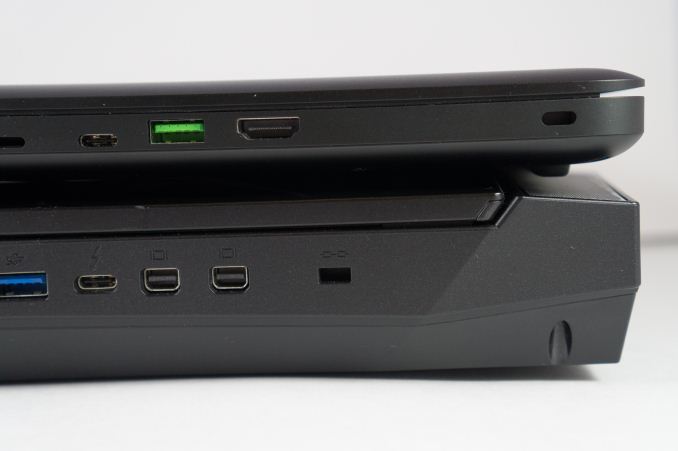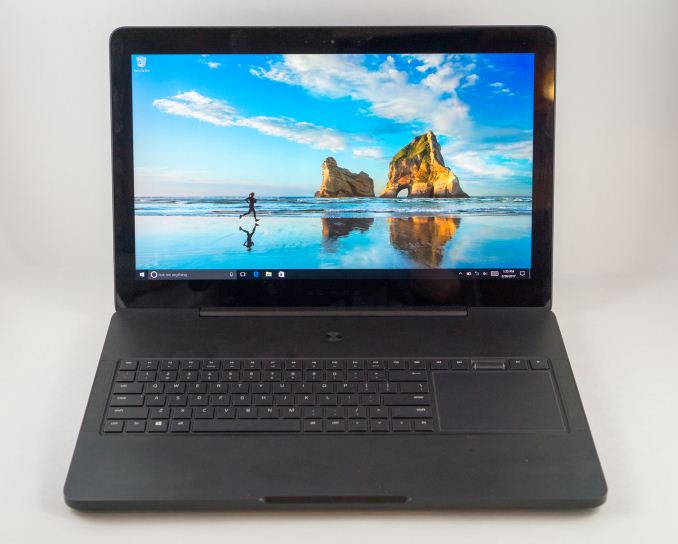The 2016 Razer Blade Pro Review
by Brandon Chester on March 6, 2017 8:00 AM EST- Posted in
- Laptops
- Razer
- Razer Blade Pro
Final Words
With the 2016 Blade Pro, Razer's goal has been to create the most powerful gaming machine possible in a form factor that is much smaller and lighter than your typical desktop replacement machine. That being said, the Blade Pro is not the kind of laptop that you'll throw in a backpack and carry around for the entire day, and despite its designation, it's not really something you'll want to use on your lap. With a mass of 3.54kg, and a large 17.3" display, it's more like a highly portable computer than a notebook.
The Razer Blade Pro is one of the most well-constructed laptops that I've used. The chassis is incredibly solid, and designing it out of a single block of aluminum allows for an enclosure without visible seams. I find the black finish quite striking as well, and it really stands out among a sea of grey plastic laptops.
The design of the laptop is a mixed bag for me. I think the keyboard and trackpad layout is interesting, and the ergonomics of it are actually quite nice. There are also some interesting design accents like the raised portions on the left and right side of the top cover. I also find some aspects of the design to be distasteful, such as the green glowing Razer logo on the back, the keyboard key font, the green accents on the USB ports, and the Chroma backlighting, although admittedly that last one can be turned off or toned down to a simple static white color. I would love a version with a totally black finish, complete with a black razer logo without the LEDs, but I understand that the green and black color scheme is closely tied with Razer's brand.
The general performance of the Blade Pro is in line with existing Core i7-6700HQ machines. I don't mean to keep bringing up the same point over and over, but with the Blade Pro being a very expensive premium machine, Razer really should have used the Core i7-6920HQ to give themselves an edge over the competition. While the Blade Pro is vastly more portable than DTR machines like the Clevo P870DM2, it still has to compete with them in the eyes of consumers, and those machines are thick and large enough to accomodate Intel's desktop CPUs. Using the Core i7-6920HQ would have helped to close the gap, and made the Blade Pro's general performance even more impressive.
Razer Blade Pro on top of a Clevo DTR
As for GPU-bound workloads, there's very few other laptops that can compete with the Blade Pro. Unless you're willing to go with a DTR, which will be twice as thick and nearly twice as heavy, the Blade Pro is the fastest laptop you'll find. Much of the gap in gaming performance actually comes from the difference in CPUs, and during my testing I observed essentially no throttling of the GPU clocks even with a long-running workload. This is a really impressive feat on the part of Razer and NVIDIA. I still find it amazing that a laptop the size of the Blade Pro greatly surpasses the performance of desktop computers with NVIDIA's GTX 980, which was the flagship card of the Maxwell generation. We've certainly come a long way from the days where the best laptop GPUs were basically equivalent to the mid-range desktop parts, and the Blade Pro is perhaps the ultimate demonstration of how far we've come.
The Blade Pro's display is not as good as I expected it to be, and it really kills the possibility of using the Blade Pro as a mobile workstation for anyone who does color-critical work. Targeting Adobe RGB without an sRGB color mode under Windows is just unacceptable, end of story. However, even if Windows did have end-to-end color management throughout all its frameworks and applications, that wouldn't change the fact that the calibration relative to Adobe RGB is not very good either. To do any sort of color-critical work, even in a color-managed application, you need to completely redo the display calibration. Fixing these problems would elevate the Blade Pro from a gaming machine to an incredible portable workstation for video editing and visual design, and it wouldn't even be very difficult. We're now living in a world where you can get perfectly calibrated displays in $600 tablets, so there's no excuse for a $3699 laptop to suffer from these issues.
As for battery life, I would say it's perfectly acceptable and actually more than I expected. Razer cannot wish away the realities of the world. A machine with this performance is going to consume a given amount of power even when it's not doing much, and the only potential optimization would be to get rid of G-SYNC so Optimus could be used, but with the goal of a gaming laptop in mind that would be a detrimental product change overall. I will say that using two separate SSDs has a power cost, although I don't think it's of much significance compared to the CPU, GPU, and display. Razer is also stuck with the battery capacity of 99Wh, unless they want to sell a laptop that you can't bring on an airplane. I would love to have a thin gaming laptop that manages to last ten hours on its battery at max performance, but as far as realistic expectations go, close to four hours of battery life for general tasks at 200 nits is quite good for a 17-inch gaming laptop.
The 2016 Razer Blade Pro is a great gaming laptop. I certainly wish I could afford one for myself. My life right now is characterized by frequent moving due to work and university, and something like the Blade Pro would allow me to bring an incredibly powerful machine with me wherever I go. While the Blade Pro fulfills its role as a high performance gaming machine, it did let me down as a mobile workstation. The issues with the display calibration and lack of an sRGB color mode make it unusable for much of the work I do. On top of that, product decisions like using two SSDs in RAID0, using Intel's slowest Core i7 H series quad core part, and using Killer's networking chips just don't make sense. With the SSDs and the networking, Razer is paying more money for a worse outcome just because it's marketable to gamers, but with the CPU they didn't spend the extra money on something that would have a real impact on performance. This isn't just a difference of opinion on what makes a good product; the choices that were made are objectively and demonstrably worse than the alternative.
In the end, the Razer Blade Pro is a powerful, portable gaming machine, but I feel that it has so much potential that can't be unlocked because of a few questionable product decisions. Most of the issues I've highlighted would be really easy to address, and it would allow the Blade Pro to be so much more than just a gaming laptop. I really like the Razer Blade Pro, and I really want one. Unfortunately, if I'm spending that much money on a laptop, I need it to truly be a no-compromises machine. As someone who needs a computer for more than playing games, it just doesn't hit that mark.













57 Comments
View All Comments
digiguy - Monday, March 6, 2017 - link
yes, it would have only impacted cost (and maybe to a limited extent noise)fanofanand - Monday, March 6, 2017 - link
It would have impacted Razer's margins, nothing more. This is a cool laptop and all, but it's maybe $1500 worth of parts (for the $3800 version) with a massive markup.fanofanand - Monday, March 6, 2017 - link
Ok maybe $2,000. I just did a quick rundown of the BOM in my head, and even without Razer getting a sweetheart deal on any of the components (which of course they do) and the BOM is $2000-$2200. Either way there are margins there that Razer is I'm sure very pleased with. Even at this stratosphere It's probably harder to sell a $5k laptop than it is a $3k laptop, so they cut corners here and there. The reviewer aptly pointed out that the CPU and screen appear to be the two corners that were cut (and the stupid killer NIC).erple2 - Wednesday, March 8, 2017 - link
The screen is actually quite good, as evidenced by the calibrated results. In face, it's exceptional. The problem is that Razer went on the cheap and didn't calibrate it at the factory. That's not hard to do in a large production plant. If a $650 iPhone can have a very accurate screen and make a handsome profit margin, a $3000 laptop can easily, too.fanofanand - Monday, March 13, 2017 - link
The difference is that Razer is not the OEM for any of the components in their laptops, whereas Apple is vertically integrated to the point where they are making their own SOCs (even if they are fabbed elsewhere). What Apple does is vastly different than what Razer does. End users (at least 99.9% of them) would not calibrate their screen. Sure, professionals who need color accuracy would, but most people won't. That's why it's so important for these companies to do the calibrations ahead of time, so the end user can just buy the thing, plug it in, and be wowed.mobutu - Monday, March 6, 2017 - link
It's unacceptable for a modern machine to have those kind of bezels.DanNeely - Monday, March 6, 2017 - link
chassis size is set by the needed component and cooling volumes on this class of laptop. That means the only way for smaller bezels would be to use a bigger panel. Unfortunately the next bigger size, 18.4" is far more niche than even 17.3" (in conventional gaming laptop form factors it's almost exclusively used for SLI models); which means that Razer might not have been able to source a good high DPI panel. Assuming not, 1080p TN would be even worse.prophet001 - Monday, March 6, 2017 - link
Too much thermal throttling.You can't dissipate enough heat out of that laptop for a 1080.
jsntech - Monday, March 6, 2017 - link
Hey guys - we're at six months post-launch for the 2016 MBPs. I saw a comment a couple/few months ago about Ryan finishing up the review back then and am surprised it's taken so long to publish. Other outlets have obviously long since put up their reviews but have sadly (and as usual) fallen short of the detail I enjoy from AT reviews. Will we see it anytime soon? Are/were there issues with review samples, etc., or ?Aman5ingh - Tuesday, March 7, 2017 - link
"As time has gone on, Razer has iterated on the original Razer Blade, and introduced both a smaller model in the form of the Razer Blade Stealth, a 14-inch model to carry on the name of the original 17-inch Razer Blade..."Nope, the 12.5" model is called the Stealth (Intel HD Graphics), the 14" model is called the Razer Blade (which has a GTX 1060), and this one is the Pro.